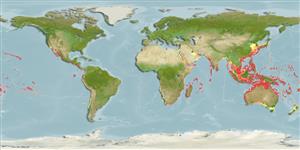Actinopterygii (ray-finned fishes) >
Tetraodontiformes (Puffers and filefishes) >
Tetraodontidae (Puffers) > Tetraodontinae
Etymology: Lagocephalus: Greek, lagos = hare + Greek, kephale = head (Ref. 45335).
Environment / Climate / Range
Ecology
Marine; reef-associated; depth range 18 - 100 m (Ref. 11441). Tropical, preferred ?
Indo-West Pacific (Ref. 4919). Lessepsian migrant to the Mediterranean Sea (Ref. 55043).
Size / Weight / Age
Maturity: Lm ? range ? - ? cm
Max length : 110 cm SL male/unsexed; (Ref. 559); common length : 40.0 cm TL male/unsexed; (Ref. 5450); max. published weight: 7.0 kg (Ref. 4919)
Inhabits offshore reefs (Ref. 9563). Sandy bottom (Ref. 95646). Caught by trammel net (Ref. 96695).
Life cycle and mating behavior
Maturity | Reproduction | Spawning | Eggs | Fecundity | Larvae
Masuda, H., K. Amaoka, C. Araga, T. Uyeno and T. Yoshino, 1984. The fishes of the Japanese Archipelago. Vol. 1. Tokai University Press, Tokyo, Japan. 437 p. (text). (Ref. 559)
IUCN Red List Status (Ref. 115185)
CITES (Ref. 94142)
Not Evaluated
Threat to humans
Poisonous to eat (Ref. 559)
Human uses
Fisheries: of no interest; aquarium: commercial
More information
ReferencesAquacultureAquaculture profileStrainsGeneticsAllele frequenciesHeritabilityDiseasesProcessingMass conversion
Tools
Special reports
Download XML
Internet sources
